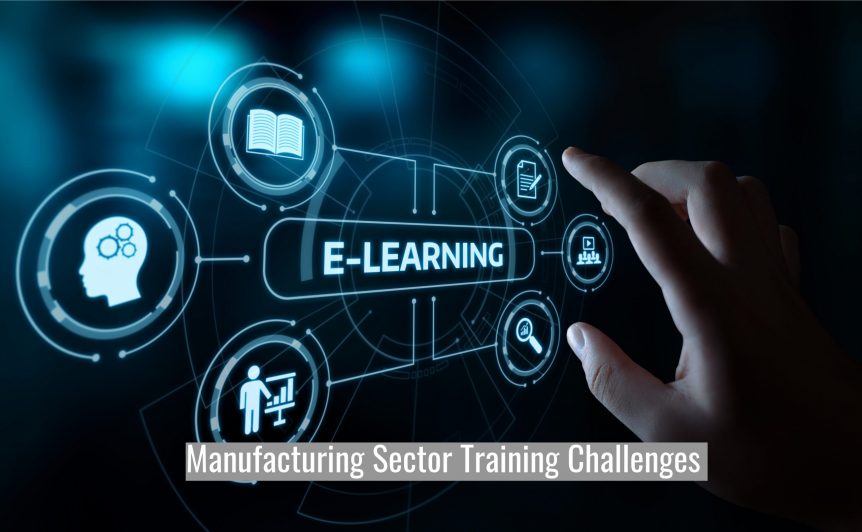Manufacturing Sector Training Challenges That E-Learning Can Help You Overcome
The manufacturing sector across a range of different industries is going through a transformation. This transformation is being driven by the development of new technologies, changing consumer expectations, increased global competition, and the impact of updated and new regulations, among other things.
The transformation that is taking place is making the process of training employees even more challenging. E-learning can help overcome the key training challenges currently faced by manufacturing companies.
Bridging Skills Gaps
Industry 4.0 technologies, processes, and strategies are becoming increasingly important for manufacturers as they work to remain competitive and to continue delivering value to their customers. Examples of the areas of Industry 4.0 that are having the biggest impact include big data, the enhanced integration of systems, and the increasing use of automated technologies not just to perform set tasks but to assess situations and conditions before making automated decisions.
The new technologies and systems that are now becoming prevalent in the Industry 4.0 era mean the skills required in manufacturing organisations are changing. This change in skills requirements is creating added pressure on the process of bridging skills gaps as the gaps are often more common, and they can be more significant.
E-learning provides a solution to bridging skills gaps. It is effective on a range of levels, including low cost of delivery. E-learning also makes it possible to create training libraries with courses that workers in manufacturing organisations can progress through as their skills improve.
Minimising the Impact on Productivity
Classroom-based training typically involves moving multiple people off a production line and into a classroom for a set period of time to complete the training. The result is often a reduction in output. In other words, training reduces productivity, albeit for a limited time.
With e-learning content, training doesn’t have to be undertaken in large groups for it to be cost-effective. Instead, workers can progress through training modules individually at times that best suit production requirements.
Ensuring Ongoing Compliance
Compliance requirements are constantly changing for manufacturers in the UAE, Saudi Arabia, and around the world. Examples of the rapidly evolving nature of compliance include health and safety as well as environmental regulations.
If you are in a highly regulated sector, such as life sciences or the food and beverage sector, there are even more regulations you need to comply with.
Furthermore, compliance training in manufacturing organisations is often about explaining procedures.
With e-learning, you can easily adapt the content in a training module as regulations change and evolve. You can also quickly produce new training materials when new compliance requirements are introduced.
E-learning is also highly effective at covering compliance topics, including those that are largely about procedures. By using e-learning as the delivery method, you can make the training more interesting and engaging, plus learners can progress through each module at their own pace, only moving on when they understand and feel confident with a step in the procedure.
Finally, the LMS (Learning Management System) that will run your e-learning content will produce documentation on who has completed training, the results achieved, and more. You can use this documentation in your compliance processes.
Ensuring Training is Consistent Throughout the Organisation
Keeping the quality of training consistent across multiple sites is a challenge faced by all companies who operate different facilities. For manufacturing companies, it is no different.
With e-learning, everyone in your organisation, regardless of where they are, will receive the same training. You can even personalise the training to make it more relevant while keeping the core content consistent.
Keeping Training Safe
There are some situations in manufacturing companies where training involves a machine or piece of equipment that can be dangerous when used incorrectly.
By using e-learning, you can conduct all or part of this training in a completely safe, virtual environment.
Elements and technologies that you can incorporate into e-learning modules that can help improve the safety of training include scenarios, digital simulations, augmented reality, and virtual reality.
Reducing Staff Turnover
Finding new people can be challenging in many manufacturing companies, and it is almost always expensive. Training new employees is also expensive. Therefore, it is important to take steps to reduce staff turnover.
E-learning is not the whole solution to this challenge, but it can help. E-learning helps by ensuring your workers have the skills they need to confidently and effectively do their job. Your workers will have a higher level of job satisfaction as a result, making them less likely to leave.
Keeping Training Content Up to Date
E-learning training content can be updated quickly and easily without having to do the entire module again.
It is the distribution of updated e-learning content that brings the real benefits, however. With e-learning, distribution is instant, so each member of your team will always have access to the most up to date training content.
Getting a Better Return on Investment from Training
Training in manufacturing companies can be costly. It is an essential process, however, so it is important to ensure you get maximum return on your investment. E-learning can help.
From reducing training costs to minimising lost productivity to improving compliance, you’ll get better results from your training spend with e-learning.
Transforming Training in Your Organisation
Training has always been a challenge for manufacturers. As mentioned earlier, these challenges are exacerbated by the transformation the sector is currently going through. The solution is to transform at least part of your training activities, moving them online through e-learning, and adopting new training technologies.
